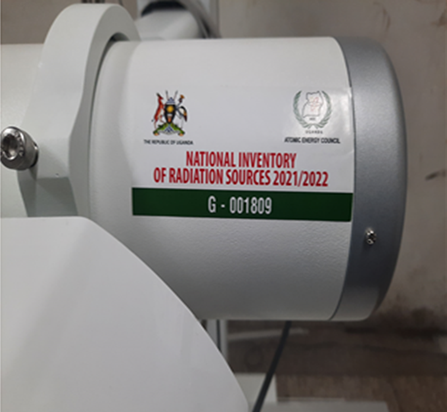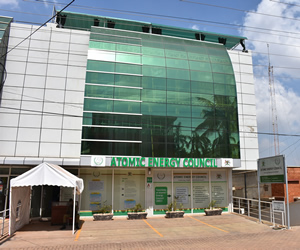No person shall acquire, own, possess, operate, import, export, hire, loan, receive, use, install, commission, decommission, transport, store, sell, distribute, dispose of, transfer, modify, upgrade, process, manufacture or undertake any practice related to the application of atomic energy…
1.0 Introduction
Authorization” means permission granted in writing by the Atomic Energy Council (AEC) to a person who has submitted an application to carry out a practice.
Under Section 32 (1) of the Act, No person shall acquire, own, possess, operate, import, export, hire, loan, receive, use, install, commission, decommission, transport, store, sell, distribute, dispose of, transfer, modify, upgrade, process, manufacture or undertake any practice related to the application of atomic energy and regulated by the Act unless permitted by an authorization issued under the Act.
Section 9 (1) (b) of the Act empowers AEC to issue authorizations and grant exemptions for the possession and use of radiation sources; Section 9 (1) (i) also empowers AEC to prescribe and collect fees for authorizations and other related services.
Through the Authorization unit, AEC performs a number of regulatory functions to ensure execution of the Atomic Energy Council mandate and these include;
- Review and Assessment of Notification and Application forms from users of ionizing radiation,
- Issuance of Authorizations to facilities and or practices that use ionizing radiation,
- Development of standards and guides,
- Maintaining a National Register of Radiation Sources,
- Conducting pre-authorization inspections in facilities,
- Participating in Public awareness activities,
- Inventorisation of radiation sources in facilities,
- Registration of new facilities with radiation sources.
2.0 Regulated Practices
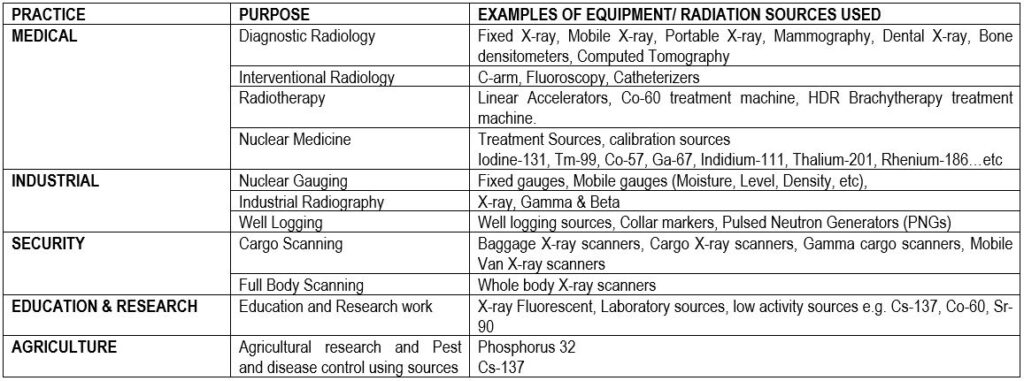
3.0 National Register of Facilities, Practices and Radiation Sources as at June 30, 2022
Section 69 of the Atomic Energy Act No. 24 of 2008 mandates the Council to establish a registry of radiation sources, practices, radioactive materials and radioactive waste. Over the years’ new facilities have been registered as shown below;
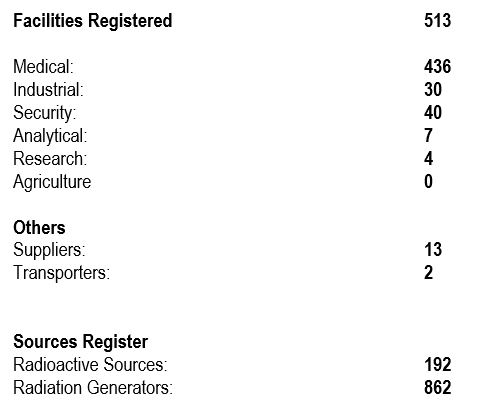
3.1 The graph below indicates the registered facilities under the different practices/categories
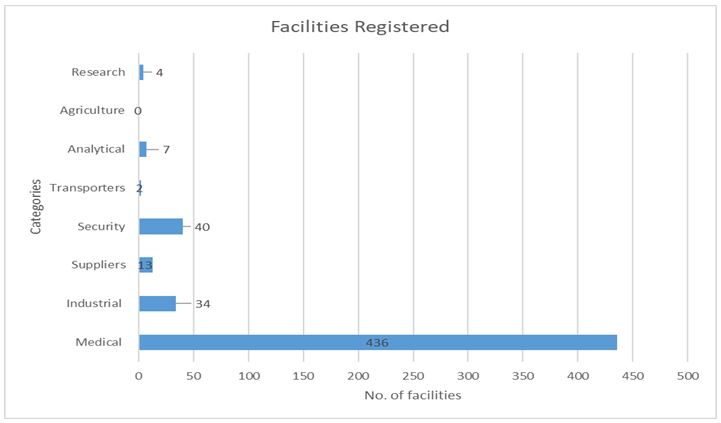
4.0 Authorization Practices
4.1 Notification of Practices
All practices and sources shall require notification as specified in Form 1A or 1B, Schedule 1.
Any person intending to initiate a practice or to possess a radiation source, shall submit a prior notification to the Council, and notices of his or her intention shall be handled in accordance with section 34 of the Act.
Regulation 13 of the Atomic Energy Regulation, 2012 (AER, 2012) provides requirements for notification.
Below are the notifications reviewed during the corresponding financial years:

4.2 Applications for Authorisation
A person shall after giving notification, apply to the Council for authorization for the intended practice, using the relevant application form in Schedule 1 of the AER, 2012. The different application forms include:
(i) Possess and Use radiation sources, Medical and Industrial. (Form 2B & 2A)
(ii) Import/Export radiation sources. (Form 4)
(iii) Transport of radiation sources within the country. (Form 8)
(iv) Sell, Transfer, and Loan or Lease a radiation source. (Form 7)
(v) Modifications of radiation devices, materials or premises. (Form 6)
(vi) Use Radiation Premises. (Form 3)
(vii) Decommission a facility with radioactive materials (Form 9)
(viii) Registration certificate to Administer Ionising Radiation to persons or patients. (Form 5)
4.2.1 Attachments to application forms for possess and use include;
- Quality Assurance Program,
- Safety Assessment Report/Qualified Expert Report,
- Local rules,
- Emergency Plan,
- Academic documents of radiation workers,
- Facility Layout & design,
- Appointment letter of Radiation Safety Officer,
- Academic documents of Radiation Safety Officer,
- Academic documents of Qualified Expert,
- Training certificates of radiation workers,
- Inventory of radiation sources,
- List of radiation workers.
4.2.2 The graph below shows the application forms reviewed during the corresponding financial years
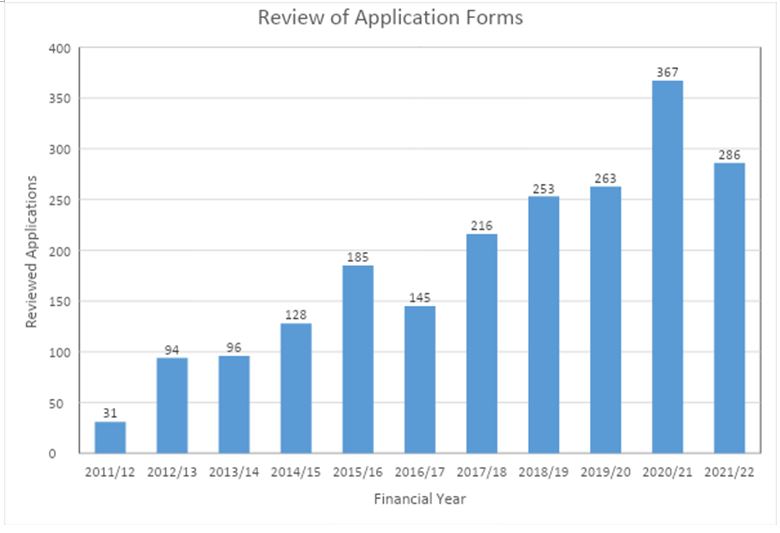
4.3 Pre-Authorisation Inspections
After Review and Assessment of Applications, pre-authorization inspections are conducted to verify the information provided as well as assess the performance of the machine and other safety (and security) related requirements in place.
4.3.1 Below is a summary of the pre-authorisation inspections conducted during the corresponding financial years
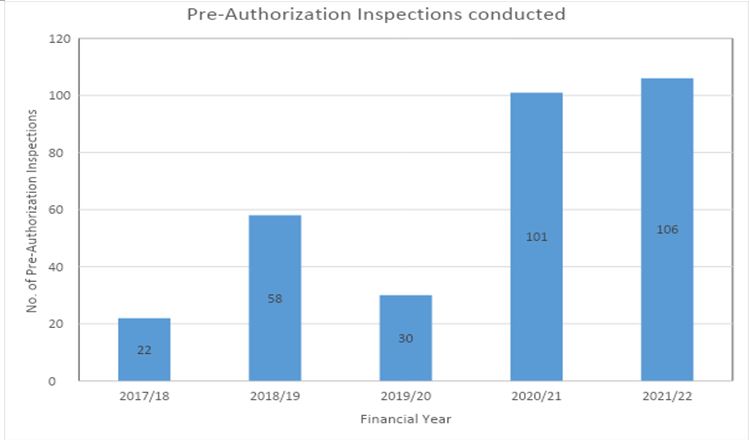
4.4 Issuance of Authorization
Authorization is of two forms;
- Licensing (Category 1-4)
- Registration (Category 5 sources)
Council issues a number of authorizations for purposes of regulating practices and activities involving the use of ionizing radiation as shown below;
(i) License to Possess and Use radiation sources (Medical and Industrial).
(ii) Permit to Import/Export radiation sources.
(iii) Permit to Transport radiation sources within the country.
(iv) Permit to Sell, Transfer, and Loan or Lease a radiation source.
(v) Permit to make Modifications of radiation devices, materials or premises.
(vi) Permit to Decommission a facility with radioactive materials
(vii) Registration certificate to Administer Ionising Radiation to persons or patients.
4.4.1 The graph below shows the licenses and permits issued during the corresponding financial years
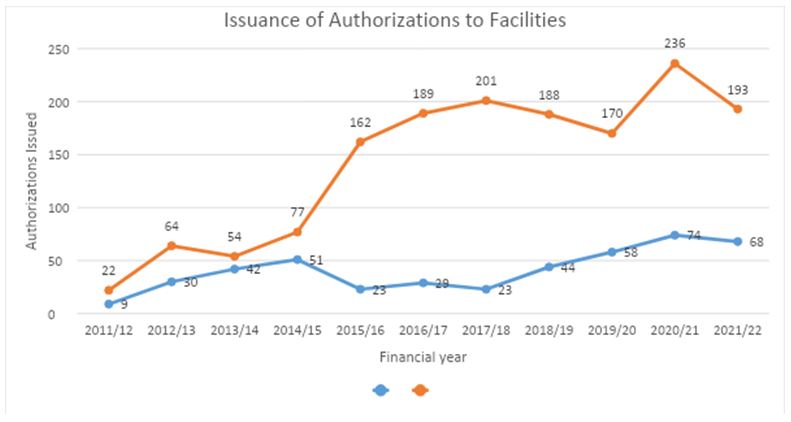
4.4.2 Duration of Authorization Renewal
Section 41(2) of the Atomic Energy Act No. 24 of 2008, requires that you apply for renewal of a license ninety days (90) before the expiry date.

4.4.3 AUTHORIZATION FEES AND CHARGES Council prescribes fees for authorization of practices as shown below;

5.0 Downloads
To facilitate the ease to acquire authorisations, relevant information is uploaded on Atomic Energy Council website (www.atomiccouncil.go.ug) where potential applicants download relevant documents. Some of the relevant documents include the following;
5.1 Notifications and Applications
(i) AEC Notification Form 1A or 1B
(ii) License to Possess and Use radiation sources (Medical and Industrial). (Form 2B & 2A)
(iii) Import/Export of radiation sources. (Form 4)
(iv) Transport radiation sources within the country. (Form 8)
(v) Sell, Transfer, and Loan or Lease a radiation source. (Form 7)
(vi) Modifications of radiation devices, materials or premises. (Form 6)
(vii) Use Radiation Premises. (Form 3)
(viii) Decommission a facility with radioactive materials. (Form 9)
(ix) Registration certificate to Administer Ionising Radiation to persons or patients (Form 5)
(x) List of attachments to application forms for Category 1 & 2
(xi) List of attachments to application forms for Category 3 & 4
5.2 Guides to filling applications
(i) Guidance for filling Notification form 1A
(ii) Guide for filling Industrial application form 2A
(iii) Guide for filling medical application form 2B
(iv) Guidance for filling decommissioning form 9
5.3 Guides to operators on documenting attachments to application forms
(i) AEC – Guidance Manual for Decommissioning of Cobalt 60 Facilities
(ii) AEC – Guidance for Medical – Documenting QA, SA, LL, EP
(iii) AEC – Guidance for Industrial – Documenting QA, LL, EPR
(iv) AEC – Guidance on the designs and layout of medical radiology facilities
5.4 Other Authorization documents
(i) Brochure Authorization
(ii) Authorisation conditions for Radiotherapy
(iii) Authorisation conditions for decommissioning a facility



